Transporting a refrigerator requires careful planning, proper equipment, and effective techniques to ensure appliance safety and successful relocation without damage during the journey.
Transporting a refrigerator in a pickup truck can be a daunting task, but with the right approach, it can be accomplished efficiently and safely. Proper planning is essential to ensure that the refrigerator remains secure during the journey. This includes understanding the fridge dimensions, preparing the appliance for transport, and utilizing the appropriate moving equipment. Weight distribution is crucial to avoid any mishaps while driving. Additionally, utilizing protective padding and securing the load will help prevent damage. By following established transport tips, you can facilitate a smooth appliance relocation experience. Whether you’re moving across town or to a new home, this guide will provide valuable insights for a successful refrigerator transport.

Understanding Refrigerator Dimensions

Before transporting a refrigerator, it is crucial to understand its dimensions thoroughly. This includes measuring the height, width, and depth of the appliance to ensure it fits securely in the pickup truck. It’s also essential to consider the space needed for protective padding and securing straps. Additionally, check for any protruding parts, such as handles or vents, that might require extra clearance; Knowing the fridge dimensions helps in planning the loading process and ensures that the truck bed can accommodate the weight and size of the appliance. Proper measurements will also aid in maintaining weight distribution, which is vital for safe transport. Accurate dimension understanding is key to a successful move.
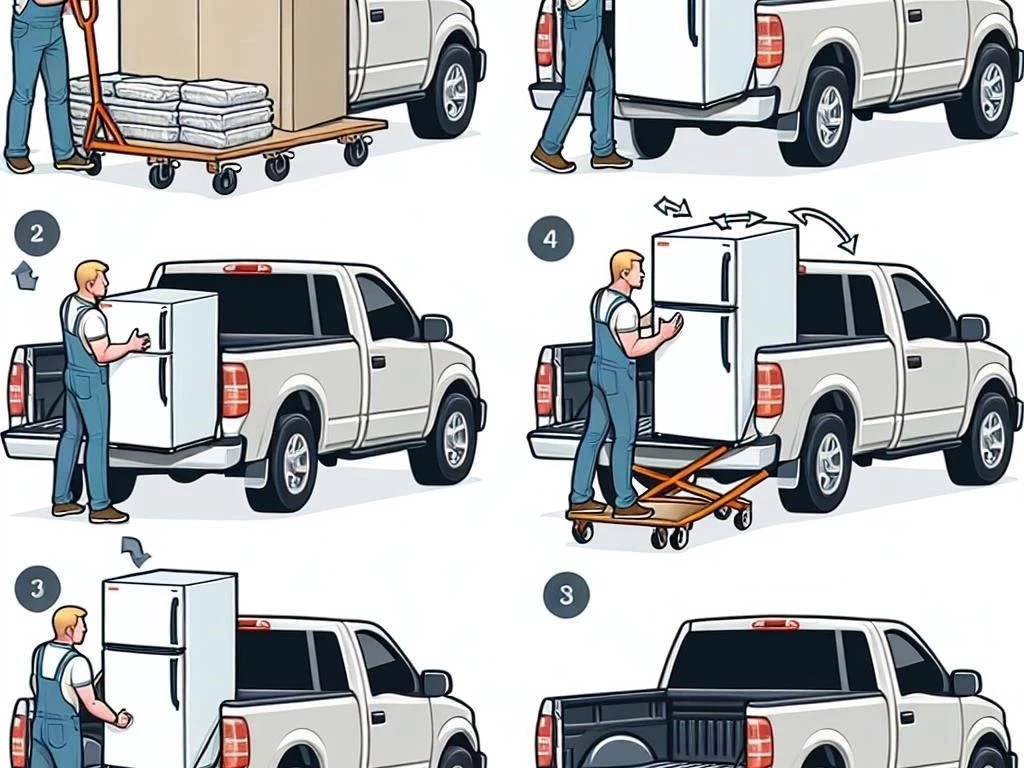
Preparing for the Move
Preparation is a vital step in transporting a refrigerator effectively. Start by gathering necessary moving supplies including a refrigerator dolly, protective padding, and tie-down straps. Assess your vehicle space to ensure that the pickup truck can accommodate the refrigerator securely. Next, empty the fridge of all contents, allowing it to defrost and dry to avoid leaks. This helps in maintaining appliance safety during the move. Disassemble any removable parts and securely pack them to prevent damage. Familiarize yourself with packing techniques to enhance stability during transportation. Finally, ensure you have adequate help for the heavy lifting and loading process. Proper preparation ensures a smoother and safer relocation experience.

3.1. Gather Necessary Moving Supplies

To ensure a successful refrigerator transport, gathering necessary moving supplies is crucial. Start with a refrigerator dolly, which enables easier maneuvering and lifting of the appliance. Next, acquire protective padding materials, such as blankets or bubble wrap, to shield the refrigerator from scratches and dents during transit. Tie-down straps or ratchet straps are essential for securing the fridge in place within the truck bed, preventing any movement while driving. Don’t forget gloves to protect your hands while lifting and moving the heavy appliance. Additionally, have tools handy for any disassembly needed prior to loading. Having these supplies ready will streamline the process and enhance overall appliance safety during transportation.
3.2. Assess Vehicle Space
Assessing vehicle space is a critical step before attempting to transport a refrigerator in a pickup truck. Begin by measuring the truck bed dimensions to ensure it can accommodate the fridge comfortably. Take into account the fridge dimensions, including height, width, and depth, to determine the best loading position. Ensure there is ample room for protective padding and securing equipment to avoid any damage during transport. Additionally, check for any obstructions in the truck bed that may hinder the loading process. Proper space assessment helps in achieving optimal weight distribution, which is vital for safe driving. Confirming vehicle space will facilitate a smoother, more secure refrigerator relocation experience.

Choosing the Right Transportation Method

Selecting the appropriate transportation method for your refrigerator is essential for a successful move. The most common option is using a pickup truck, which offers sufficient space and stability for hauling. Ensure the truck bed is clean and free from debris to prevent any damage during loading and transport. If a pickup truck isn’t available, consider alternative transportation options such as renting a moving truck or using a trailer designed for appliances. Regardless of the method, prioritize secure loading and proper use of protective padding to minimize the risk of damage. Evaluating your transportation method carefully will help guarantee that the refrigerator arrives safely at its new location.

4.1. Pickup Truck Loading

Loading a refrigerator into a pickup truck requires careful planning and execution to ensure safety and efficiency. Begin by positioning the refrigerator dolly next to the appliance, ensuring it is ready for lifting. Tilt the fridge slightly and slide the dolly underneath, securing it firmly. With assistance, carefully lift the refrigerator onto the truck bed, using proper lifting techniques to avoid injury. Ensure the fridge is placed flat, as upright positioning can damage internal components. Once loaded, use protective padding around the appliance to prevent scratches and secure it with tie-down straps. This methodical loading process ensures that the refrigerator remains stable during transport, minimizing the risk of damage or accidents.
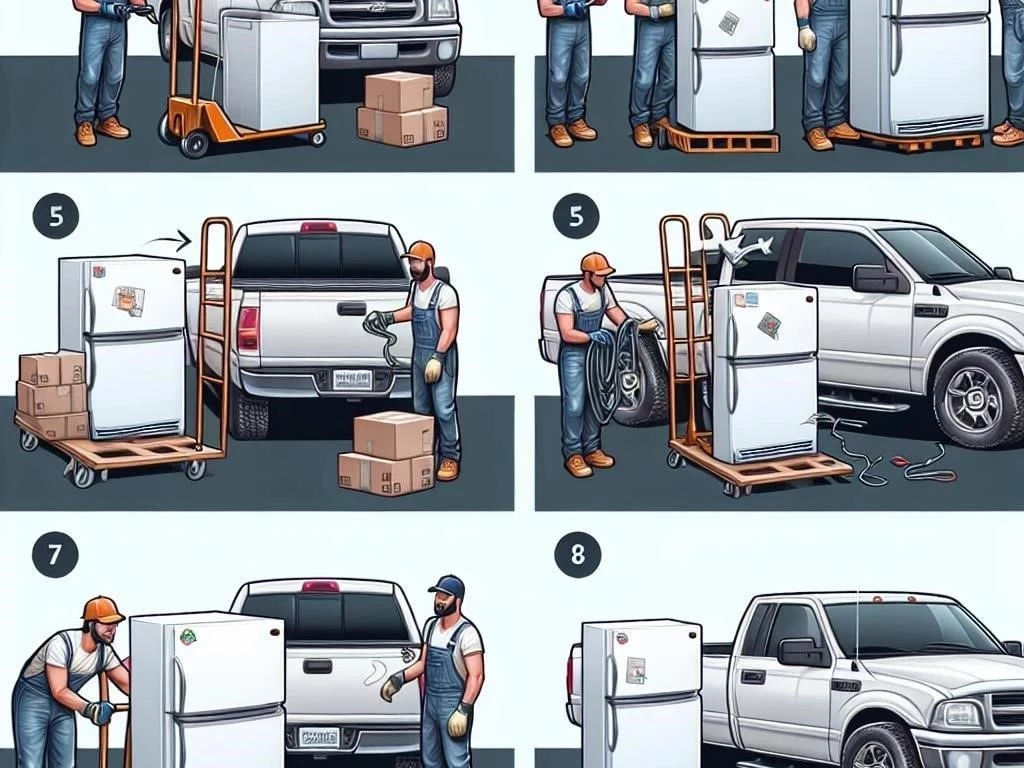
4.2. Alternative Transportation Options
If a pickup truck is unavailable or unsuitable for your refrigerator transport, consider several alternative transportation options. Renting a moving truck provides ample space and stability for larger appliances, ensuring safe transport. Look for trucks specifically designed for moving appliances, which often include features like ramp access for easier loading. If you’re relocating a short distance, a trailer can also be a viable option; ensure it is equipped with proper tie-downs. Additionally, some moving companies offer specialized appliance relocation services, ensuring professional handling. Always prioritize securing the refrigerator properly, regardless of the transportation method chosen, to guarantee its safety and prevent damage during the move.
Preparing the Refrigerator for Transport
Preparing the refrigerator for transport is crucial to ensure its safety during the move. Start by emptying the contents, removing all food and beverages, to prevent spills or spoilage. Unplug the appliance and allow it to defrost completely, which may take several hours. Once defrosted, wipe down any moisture to avoid mold or unpleasant odors. Next, secure any loose parts, such as shelves and drawers, by removing them and packing them separately, if necessary. Wrap the refrigerator in protective padding or blankets to shield it from scratches during transport. Finally, tape the doors shut to prevent them from swinging open while moving. These steps ensure a smooth and safe relocation process.
5.1. Emptying the Refrigerator

Emptying the refrigerator is a crucial step in preparing for transport. Begin by removing all food items, including perishables and frozen goods, to prevent spoilage or mess during the move. Check for any items in the door compartments, such as condiments or drinks, and take them out as well. Once the fridge is completely empty, be sure to dispose of any expired items properly. After clearing out the contents, unplug the appliance and allow it to defrost completely, which can take several hours. This process is essential to avoid water leaks and potential damage to the truck during transport. Ensure to wipe down any moisture inside before loading.
5.2. Securing Load with Protective Padding

Securing the load with protective padding is essential for safeguarding the refrigerator during transport. Begin by wrapping the fridge in moving blankets or bubble wrap, ensuring every surface is covered to prevent scratches and dents. Pay special attention to corners and edges, as these areas are particularly vulnerable. After wrapping, use packing tape to secure the padding in place, preventing it from shifting during transport. Additionally, consider placing a layer of cardboard between the fridge and the truck bed to provide extra cushioning. This protective layer absorbs shocks and vibrations while driving, enhancing appliance safety. Properly securing the load with protective padding minimizes damage and ensures a smooth relocation experience.

Using a Refrigerator Dolly
Using a refrigerator dolly can significantly simplify the process of moving appliances. This specialized equipment is designed to support the weight and dimensions of refrigerators, making them easier to maneuver. To begin, ensure that the dolly is in good condition and capable of handling the fridge’s weight. Position the dolly next to the refrigerator, tilting the appliance slightly to slide the dolly’s platform underneath. Secure the fridge to the dolly using straps or safety belts to prevent any slippage. When moving, maintain a stable stance and use your legs for lifting to avoid injury. The dolly allows for smoother navigation through doorways and tight spaces, enhancing overall transport efficiency.
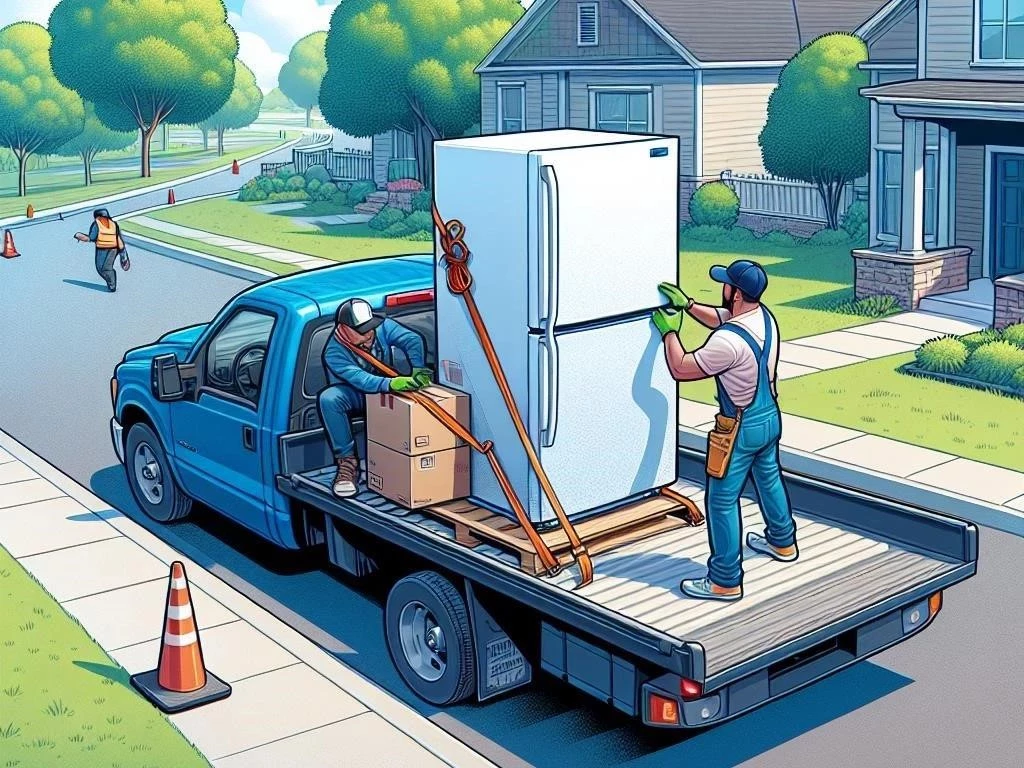
6.1. Selecting the Right Dolly
Selecting the right dolly is crucial for safely transporting a refrigerator. Look for a refrigerator dolly specifically designed for heavy appliances, featuring a sturdy frame and high weight capacity. Ensure the dolly has a wide base for better stability, which helps in balancing the fridge during movement. Large, pneumatic wheels are advantageous for navigating various terrains, including stairs or uneven surfaces. Some models also come with straps or harnesses to secure the refrigerator during transport, providing additional safety. Check for ergonomic handles that allow for easier maneuvering without straining your back. Choosing the right dolly not only simplifies the moving process but also enhances appliance safety throughout the journey.

6.2. Properly Loading the Fridge onto the Dolly
Properly loading the refrigerator onto the dolly is essential for safe transport. Start by positioning the dolly next to the fridge, ensuring it’s stable and secure. With assistance, tilt the refrigerator slightly while sliding the dolly’s platform underneath. Ensure the fridge is centered on the dolly to maintain balance during movement. Once in place, use heavy-duty straps to secure the refrigerator to the dolly, preventing any shifting while moving; It’s important to lift using your legs, not your back, to avoid injury. When ready, carefully tilt the dolly back, keeping the refrigerator upright to protect its internal components. This methodical approach ensures safe and efficient loading for transport.
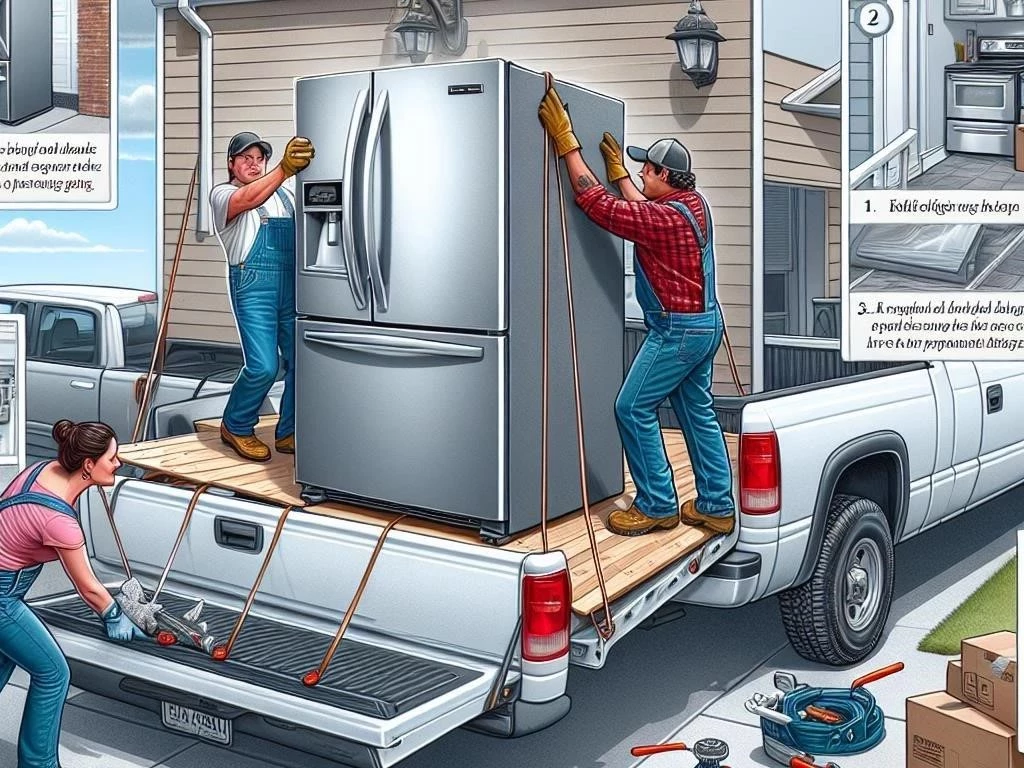
Loading the Refrigerator onto the Truck Bed

Loading the refrigerator onto the truck bed requires careful coordination and technique to ensure safety. Begin by positioning the dolly with the secured refrigerator near the truck bed. If available, use a loading ramp for a smoother transition. Tilt the dolly back slightly, aligning the refrigerator with the truck bed. With assistance, gently push the dolly forward, guiding the fridge onto the truck bed, ensuring it remains upright throughout the process. Once the refrigerator is on the bed, position it centrally to maintain proper weight distribution. Use protective padding beneath the appliance to prevent damage. Finally, secure the refrigerator with straps or tie-downs to prevent movement during transport.
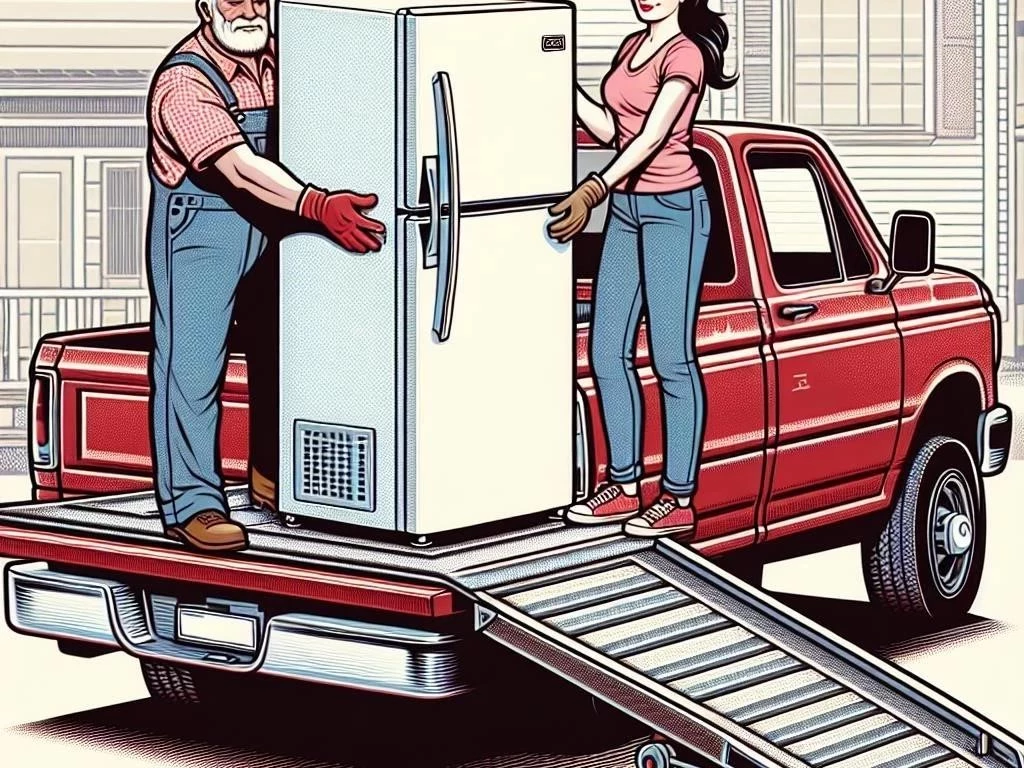
7.1. Techniques for Hauling Fridge
Employing effective techniques for hauling a refrigerator is essential for ensuring safety and efficiency. Start by using a refrigerator dolly, which is specifically designed to support heavy appliances. When lifting, always bend at the knees and keep your back straight to prevent injury; Communicate clearly with your helper to coordinate movements, especially when navigating tight spaces or doorways. Use slow, deliberate motions to maintain control over the refrigerator, avoiding sudden jerks that could lead to accidents. When tilting the dolly, ensure the refrigerator remains upright to protect its internal components. Finally, secure the fridge to the dolly with straps for added safety during transport, minimizing risks throughout the haul.
7.2. Weight Distribution Considerations
Weight distribution is a critical factor when transporting a refrigerator in a pickup truck. Properly distributing the weight helps maintain vehicle stability during transit, reducing the risk of accidents. Position the refrigerator centrally in the truck bed, as this will ensure an even weight load across the axles. Avoid placing the fridge too far forward or backward, as this can lead to swaying or uneven handling. Additionally, consider the total weight capacity of the truck, including other items being transported. If necessary, adjust the load by moving other items or redistributing weight to achieve balance. Attention to weight distribution enhances safety and improves overall driving performance during the journey.
Securing the Refrigerator in the Truck
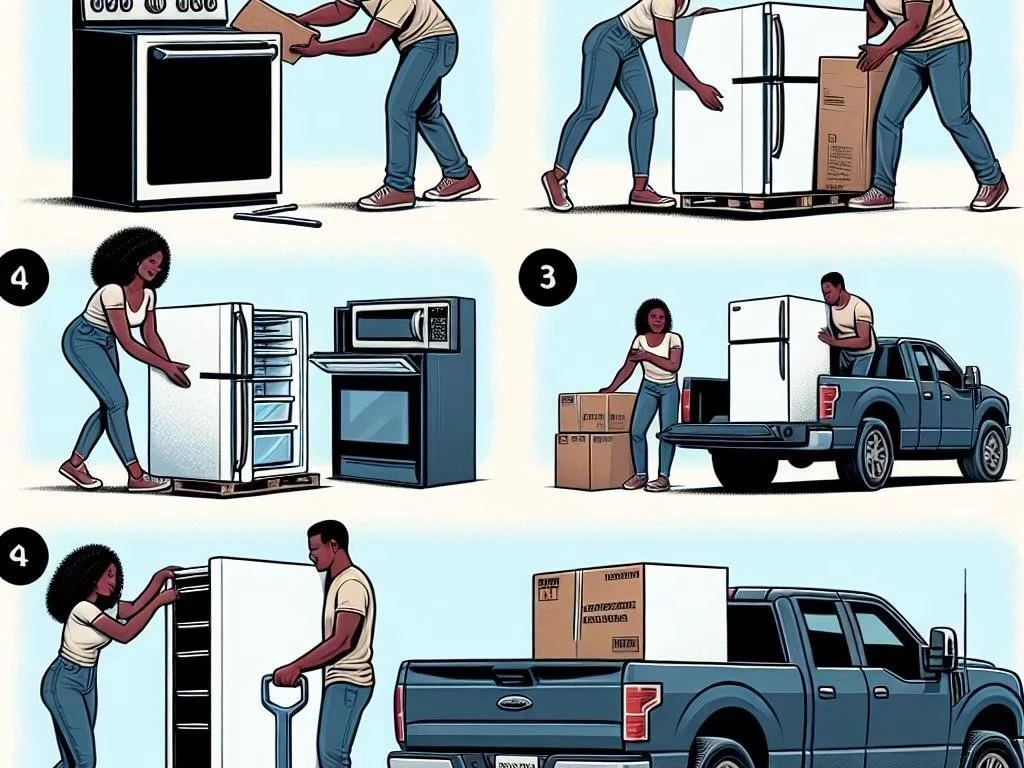
Securing the refrigerator in the truck is essential to prevent movement and ensure safety during transport. Start by using heavy-duty tie-down straps or ratchet straps to secure the fridge to the truck bed. Attach one end of the strap to a sturdy anchor point in the truck, such as the built-in hooks or tie-down points. Wrap the strap around the refrigerator, ensuring it is tight but not overly constricting to avoid damage. Use multiple straps if necessary, positioning them at different heights to distribute pressure evenly. Additionally, check that the fridge remains upright and stable before driving. Regularly inspect the load during stops to ensure it remains secure throughout the journey.
8.1. Using Straps and Tie-Downs
Using straps and tie-downs effectively is crucial for securing the refrigerator in the truck. Begin by selecting high-quality, heavy-duty straps designed for transporting appliances, ensuring they can withstand the weight. Attach one end of each strap to the truck’s anchor points, which may include built-in hooks or designated tie-down locations. Loop the strap around the refrigerator, ensuring it is snug but not overly tight to avoid damaging the appliance. If necessary, use multiple straps at varying heights to enhance stability and weight distribution. After strapping, double-check the security of each connection, making sure the refrigerator remains upright and does not shift. This careful approach minimizes risk during transport and enhances overall safety.

8.2. Ensuring Appliance Safety During Transit
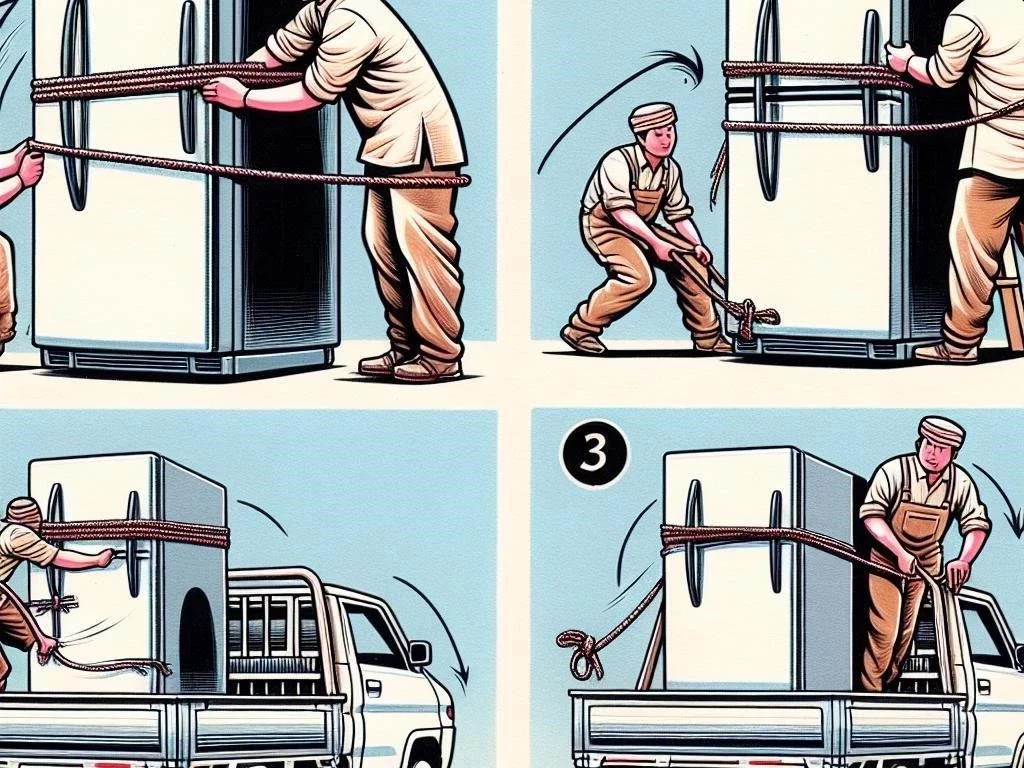
Ensuring appliance safety during transit is vital to prevent damage to your refrigerator. Begin by verifying that the refrigerator is securely strapped down in the truck bed, minimizing movement. Use protective padding around the appliance to absorb shocks and vibrations that may occur during travel. Additionally, maintain the refrigerator in an upright position to protect its internal components. Avoid sudden stops or sharp turns while driving, as these maneuvers can cause the fridge to shift. Regularly check the load during breaks to ensure it remains secure and stable. By taking these precautions, you can safeguard your refrigerator, ensuring it arrives at its destination in perfect condition and ready for use.
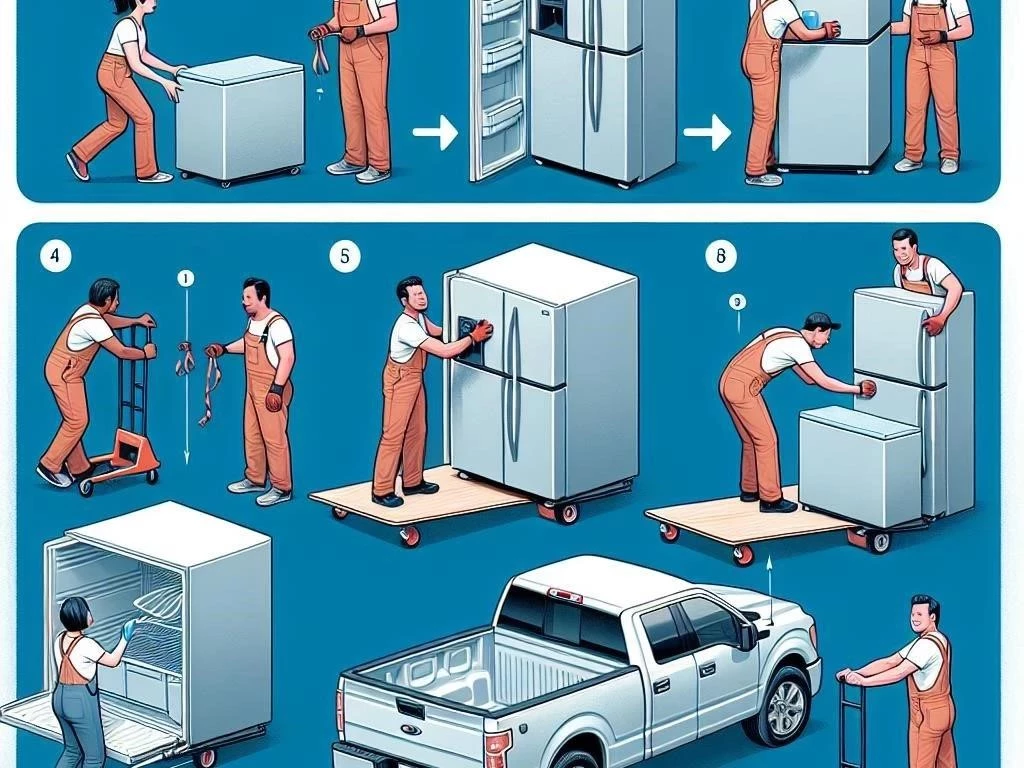
Transport Tips for a Smooth Journey
Transporting a refrigerator requires careful planning to ensure a smooth journey. Start by checking the truck’s weight capacity to avoid overloading. Ensure that the refrigerator is securely fastened and stable in the bed, minimizing the risk of movement. Before hitting the road, plan your route to avoid bumpy roads or sharp turns that could disturb the load. Drive at a consistent speed, avoiding sudden accelerations or stops to maintain stability. Take frequent breaks to check the load, ensuring everything remains secure. Additionally, consider using a spotter to help guide you when navigating tight spaces or loading and unloading. These tips will help ensure a safe and efficient transportation experience;
9.1. Driving Considerations

When transporting a refrigerator, several driving considerations are essential for a safe journey. First, drive at a moderate speed, as excessive speed can lead to instability in the truck bed, increasing the risk of accidents. Maintain a safe distance from other vehicles to allow for gradual stopping, minimizing the chance of sudden jolts that could shift the load. Be particularly cautious on turns, avoiding sharp angles that may cause the refrigerator to topple or slide. Use smooth acceleration and braking to keep the load steady, and be aware of road conditions, such as potholes or uneven surfaces. Following these driving considerations ensures both safety and appliance integrity throughout the trip.

9.2. Monitoring the Load

Monitoring the load during transportation is crucial for ensuring the refrigerator’s safety and stability. Periodically check the straps and tie-downs to confirm that they remain secure and tight, as vibrations and movement can loosen them over time. Schedule regular stops, especially on longer trips, to inspect the refrigerator’s position in the truck bed, ensuring it has not shifted or tilted. Additionally, pay attention to any unusual sounds or vibrations while driving, as these may indicate potential issues with the load. If you notice any problems, pull over safely to address them immediately. By maintaining vigilance and monitoring the load, you can prevent damage and ensure a successful transport experience.

Unloading the Refrigerator
Unloading the refrigerator safely is as important as loading it. Begin by positioning the dolly next to the truck bed, ensuring you have enough space to navigate. Carefully release the straps securing the refrigerator, maintaining a firm grip to prevent any sudden shifts. Tilt the dolly back slightly to stabilize the fridge, then slowly guide it off the truck bed. Communicate with any helpers to ensure coordinated movements, especially when navigating down ramps or stairs. Once on the ground, gently lower the refrigerator to its upright position. Avoid dropping or jarring the appliance, as this can damage internal components. Finally, check for any signs of damage before plugging in the refrigerator at its new location.
10.1. Safety First: Getting the Fridge Off the Truck

Prioritizing safety is essential when getting the fridge off the truck. Start by ensuring the area surrounding the truck is clear of obstacles, providing ample space to maneuver. Begin by carefully loosening and removing any straps securing the refrigerator, ensuring you maintain a steady grip. Position the dolly securely against the truck bed, then tilt the refrigerator slightly towards the dolly while carefully sliding it off the truck. Ensure that one person steadies the fridge while another guides it down. Use a ramp if available for a smoother transition, preventing potential injuries caused by lifting. Always keep the refrigerator upright to protect its internal components during this unloading process.
10.2. Setting Up the Refrigerator at Its New Location

Setting up the refrigerator at its new location involves careful positioning and installation. First, choose a level surface that allows for proper airflow around the appliance. Avoid placing the fridge near heat sources, such as stoves or direct sunlight, to ensure optimal efficiency. Once in position, plug the refrigerator into a compatible power outlet, ensuring the cord is not pinched or damaged. Allow the fridge to settle for several hours before turning it on, especially if it was transported on its side. After powering it up, adjust the temperature settings and ensure the doors seal properly. Finally, check for any unusual sounds, confirming that the refrigerator operates smoothly in its new environment.

Transporting a refrigerator in a pickup truck requires careful planning, proper equipment, and effective techniques to ensure a safe and smooth journey. By understanding refrigerator dimensions, gathering necessary moving supplies, and employing best practices for securing and unloading, you can minimize risks during the relocation process. Attention to weight distribution, monitoring the load, and following driving considerations further enhances safety. Once at the destination, proper setup and settling time are crucial for optimal performance. With these guidelines, you can successfully transport your appliance without damage, ensuring it operates efficiently in its new location. Prioritizing safety and careful handling ultimately guarantees a successful refrigerator relocation experience.